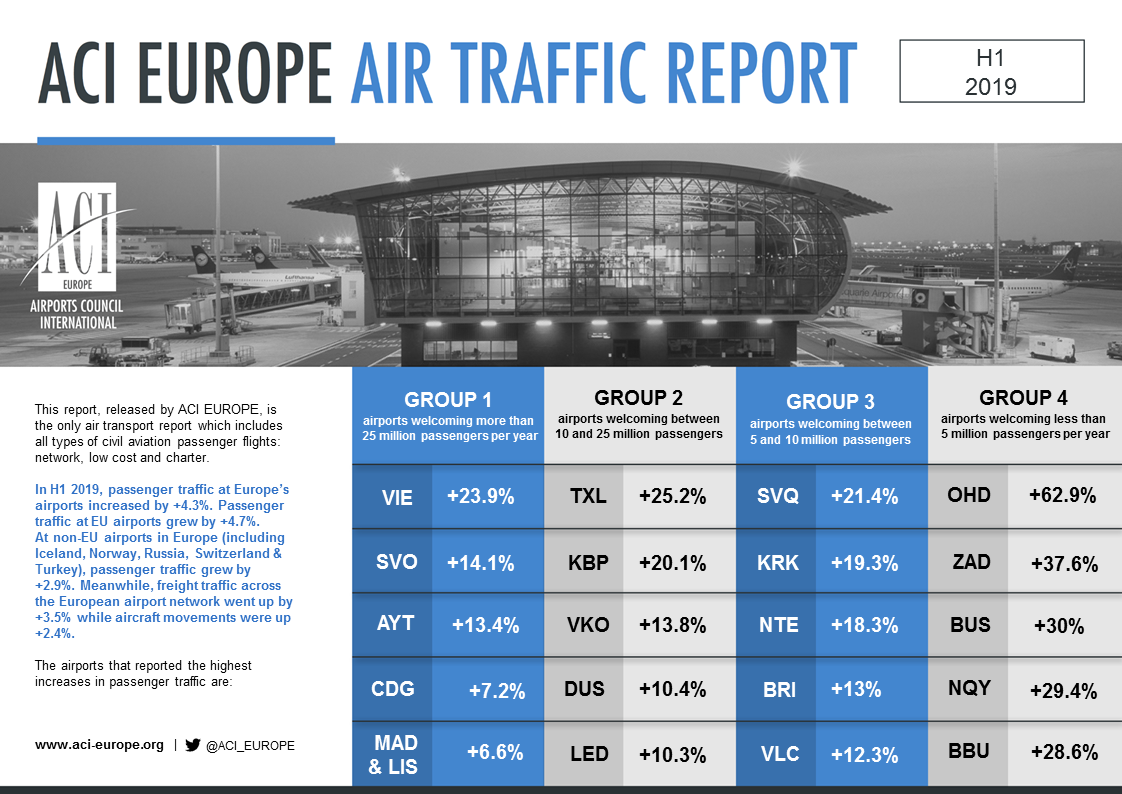Passenger traffic at Europe’s airports grew by +4.3% during the first half of this year – a significantly slower rate than last year (+6.7%).
BRUSSELS – European airport trade body, ACI Europe, released its air traffic report for June, Q2 & H1, measuring all types of civil aviation passenger flights: full service, low cost and charter.
The report reveals that passenger traffic at Europe’s airports grew by +4.3% during the first half of this year – a significantly slower rate than last year (+6.7%).
Olivier Jankovec, Director General of ACI Europe commented “Passenger traffic growth has certainly slowed this year compared to previous ones, but it still remains quite resilient – especially given the range of economic, geopolitical and other industry-specific challenges we are confronted with. Slowing economic growth in Europe, trade wars and Brexit are not helping – and neither are rising fuel bills, ATM disruptions, airline consolidation and aircraft grounding & delivery delays. Aircraft movements have been continuously slowing down – from +6.2% last December to just +1.6% in June. This shows just how risk averse airlines have become in terms of capacity deployment & network development.”
He added “The slump in freight traffic is where it really bites at the moment. And it is not getting any better, with June registering a drop of -7.1% – the worst monthly performance in more than 7 years. This does not bode well for the months ahead, especially as passenger traffic usually does not remain totally isolated from trends in freight traffic.”
EU Airports Passenger Traffic in the Lead at +4.7%
The EU market maintained steady growth during H1, with passenger traffic performance holding steady between 4.5% to 5% on a month-by-month basis over the period.
Airports in Austria (+20%), Croatia (+10.5%) and Estonia (+10.5%) posted double-digit growth in H1, with those on Luxembourg, Portugal, Spain, Latvia, Poland, Hungary and Romania also growing well above the EU average. Conversely, Bulgaria (-2.5%) and Sweden (-4.1%) reported passenger traffic declining while growth was flat in neighbouring Denmark (+0.3%). Belgium, the Netherlands, Slovenia and the UK significantly underperformed the EU average – with the latter further slowing down in June (+0.9%).
Accordingly, amongst larger/capital EU airports, the best results were achieved by Berlin TXL (+25.2%), Vienna (+23.9%), Tallinn (+10.5%), Dusseldorf (+10.4%), Milan Malpensa (+10.2%), London Luton (+9.6%), Riga (+9.5%) Luxembourg (+9.0%), Bucharest Otopeni (+8.2%), London City (+7.8%), Athens (+7.7%), Budapest (+7.5%) and Warsaw (+7.4%).
Non-EU Airports Passenger Traffic at +2.9%
Airports in the non-EU market grew at a slower pace in H1, mainly due to traffic losses in Turkey (-1.4% – as a result of the recession affecting the country) and Iceland (-20.3% – following the bankruptcy of WOW in the final days of March) as well as nearly flat growth in Norway (+0.9%).
However, passenger traffic in Ukraine, Georgia, Albania and Northern Macedonia remained extremely dynamic, achieving double-digit growth. It is also worth noting that passenger traffic in Turkey improved in Q2 and ended up posting an impressive +7.1% growth in June – signaling a recovery.
The best performances amongst larger/capital non-EU airports came from Kyiv-Boryspil (+20.1%), Moscow-Sheremetevo (+14.1%), Moscow-Vnukovo (+13.8%), Antalya (+13.4%), Pristina (+12.5%), Tbilisi (+11.7%), Tirana (+11.1%), and Saint Petersburg (+10.3%).
Majors & Smaller Regional Weaker
Passenger traffic at the Majors (top 5 European airports) grew by just +2.3% during H1. Paris CDG (+7.2%), led the league, followed by Frankfurt (+3.0%), while gains were limited at capacity constrained London-Heathrow (+1.7%) and Amsterdam-Schiphol (+1.4%). Istanbul-IST/ISL? saw passenger traffic receding (-2%).
Many larger regional airports achieved double-digit passenger traffic growth in H1, including Seville (+21.4%), Krakow (+19.3%), Nantes (+18.3%), Bari (+13%), Valencia (+12.3%), Bordeaux (+12%), Naples (+10.8%), Bologna (+10.3%), Sochi (+10.2%) and Porto
(+10%). However, smaller regional airports significantly underperformed, with their passenger traffic barely increasing at +1%. Yet, some managed to post impressive growth, such as Ohrid (+62.9%), Zadar (+37.6%), Batumi (+30%), Newquay (+29.4%), Kharkiv (+25.5%), Memmingerberg (+25.4%), Sibiu (+25%), Dubrovnik (+17.4%), Iasi (+16.8%), Brno (+17.7%) and Ostend (+15.4%), Kaunas (+15.1%) and Brest (+13.9%).
H1 Top 5s
During H1, airports welcoming more than 25 million passengers per year (Group 1), airports welcoming between 10 and 25 million passengers (Group 2), airports welcoming between 5 and 10 million passengers (Group 3) and airports welcoming less than 5 million passengers per year (Group 4) reported an average adjustment +3.9%, +6.1%, +4.2% and +1.9%.
The airports that reported the highest increases in passenger traffic are as follows:
- Group 1: Vienna (+23.9%), Moscow SVO (+14.1%), Antalya AYT (+13.4%), Paris CDG (+7.2%) and Madrid & Lisbon (+6.6%)
- Group 2: Berlin TXL (+25.2%), Kyiv-Boryspil KBP (+20.1%), Moscow VKO (+13.8%), Dusseldorf (+10.4%) and St Petersburg (+10.3%)
- Group 3: Seville (+21.4%), Krakow (+19.3%), Nantes (+18.3%), Bari (+13%) and Valencia (+12.3%)
- Group 4: Ohrid (+62.9%), Zadar (+37.6%), Batumi (+30%), Newquay (+29.4%) and Bucharest (+28.6%)
The 'ACI Europe Airport Traffic Report – June, Q2 & H1 2019’ includes 242 airports in total representing more than 88% of European air passenger traffic.
Due to the new Istanbul airport fully taking over passenger traffic from Istanbul-Ataturk on 5 April 2019, the figure reported is based on the passenger traffic handled by Istanbul-Ataturk until and subsequently on the passenger traffic handled by the new Istanbul airport.
Tatiana is the news coordinator for TravelDailyNews Media Network (traveldailynews.gr, traveldailynews.com and traveldailynews.asia). Her role includes monitoring the hundreds of news sources of TravelDailyNews Media Network and skimming the most important according to our strategy.
She holds a Bachelor's degree in Communication & Mass Media from Panteion University of Political & Social Studies of Athens and she has been editor and editor-in-chief in various economic magazines and newspapers.




































































































































































